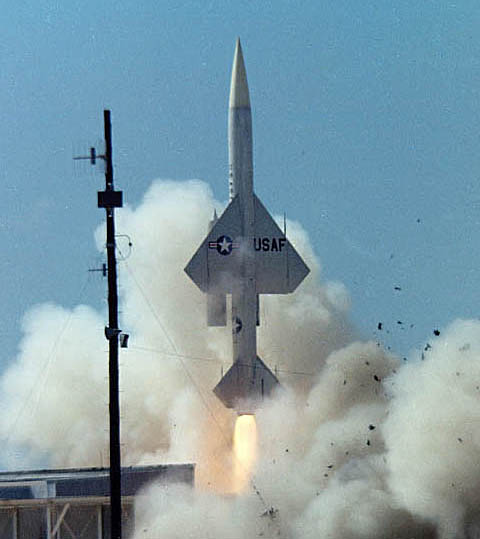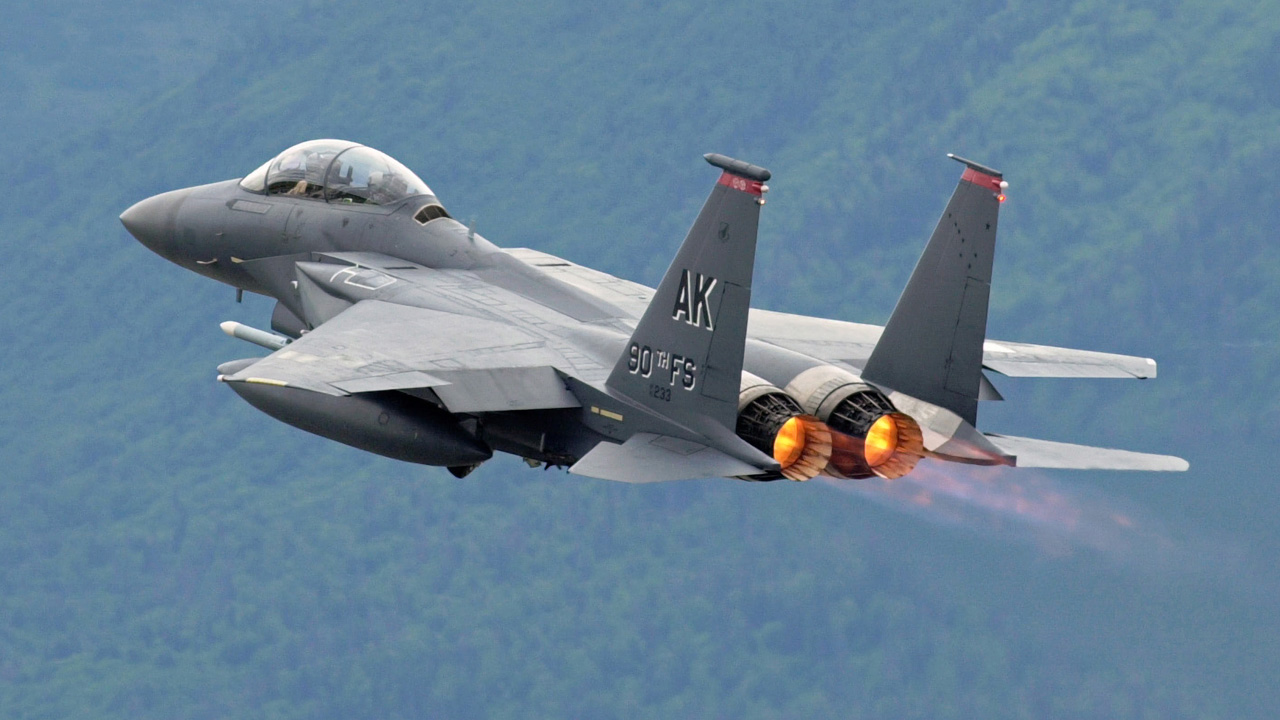
Kincheloe Air Force Base (formerly Kinross AFB) was home to the 438th Fighter Interceptor Squadron from April of 1953 until August of 1968. Kinross’ name was changed to Kincheloe after Captain Iven Kincheloe who was the first pilot to climb to an altitude above 100,000 feet (he reached 126,200). He achieved this on September 7th 1956 and died less than two years later in a Starfighter crash in California. During this time the Squadron was equipped with F-94B Starfires to F-89D Scorpions to F-102 Delta Daggers to their final plane before decommissioning, the F-106 Delta Dart. Kincheloe AFB and subsequently the 438th Fighter Interceptor Squadron was one of several first defense systems in place in the event that the USSR may try to initiate a bomber attack upon the United States. The Squadron along with the Boeing and Michigan Aeronautical Research Center (BOMARC) missile site near Kinross were all part of a system of defense sites located throughout the Upper Great Lakes Region. Specifically in Michigan, the Sault Ste. Marie, Grand Marais, Calumet, Alpena, and Empire Air Force Stations were all a part of the surveillance umbrella network that would alert the Squadron of unknown aircraft invasions of American airspace.

The 438th Fighter Interceptor Squadron was involved with several major points of the Cold War. The Squadron was put on alert during the Cuban Missile Crisis for several days, and although it never had to fulfill its primary mission of intercepting unknown aircraft, the efforts of the 438th along with all other FI Squadrons were another piece in the Cold War weapons race. These pieces, however, eventually became outdated by the beginning of the 70’s due to the creation of the Inter-Continental Ballistic Missile (ICBM). The development of these missiles essentially made a bomber based attack highly unlikely and also ineffective and so the need for FISs was unnecessary. (8.)
Life on the Base
A day in the life of personnel on the grounds of Kincheloe Air Force Base was relatively relaxed. The greatest threat that Kincheloe saw in its active years was the Cuban Missile Crisis which still hardly affected the overall livelihood of civilians and military persons alike besides some psychological stress. In the downtime the 438th FIS as well as the nearby BOMARC missile site crews and all other base staff performed routine tests, drills, and general maintenance. They also enjoyed making light of the impressive amounts of snow they would receive. The base also had a newspaper to share all of the relevant news of the base community, called “The Chieftain.” (3.)

BOMARC Missile
BOMARC missiles were another primary feature of the greater Sault area and specifically the Sault Ste. Marie Air Defense Sector (of which the 438th Fighter Interceptor Squadron was a member) and they were controlled by the Semi Automatic Ground Environment (SAGE) Data Center. This network was computer-controlled and it linked the Air Force with General Surveillance Radar stations into a centralized center for Air Defense. This was implemented as an early warning system against a Soviet nuclear attack. The SAGE network worked hand in hand with both the BOMARC missile site and the 438th FIS to communicate any unidentified aircraft in the Upper Great Lakes region. The BOMARC missile didn’t have the longest shelf life in the military’s usage span, but it was the primary Surface-to-Air Missile (SAM) used during Kincheloe’s high time as well as the time period that the 438th FIS was active at Kincheloe. The BOMARC site related to Kincheloe was located just a few miles away where they had launch bays and the necessary equipment for servicing and launching their missiles. The BOMARCs, along with most ballistic warheads during the Cold War, were never used and nearly all of them were decommissioned shortly after newer, more efficient, missile models were introduced in the late 60’s. However some saw flight in the form of drone usage or as dummy test flight missiles. (6. & 9.)

SAGE Defense System
The SAGE computer network was one of the first uses of a computer network and certainly one of the largest of its scale at the time. The history of computational technologies and the ability to connect those devices through an integrated wired and wireless network was surely rooted in the SAGE system and similar systems throughout the country. The SAGE network was an extensive part of our country’s defense system beginning in the 50’s and computer network security systems today continue to provide that same level of continued communicational and tactical connection to our armed forces. In fact, the entire project (originally named Project Lincoln) exceeded the expenses and manpower utilized in the Manhattan Project. The best aspect of the SAGE system was its real-time connection to computer systems within FIS aircraft such as the Delta Dart and some of the previous Interceptor plane models. This then allowed fighter pilots to give and receive accurate information about potential threats approaching our airspace. All of this was facilitated through the use of live radar communication between the ground radar stations and aircraft and then the links to the central data centers for command control. As is always the case in technological warfare there is a constant tug-of-war (pun intended) between offensive and defensive components of war. Although never given the chance to prove its total effectiveness against the weaponry at the time, (like the ironclad submarines of the Civil War) the SAGE system was nonetheless an integral piece of the Cold War era. (1. & 7.)
Four Hundred and Thirty Eighth Fighter Interceptor Squadron
The 438th’s primary mission was to intercept and, if necessary, destroy potential aerial threats to the American homeland. Although Kincheloe’s Squadron never saw combat they stood on guard for just over 15 years at Kincheloe alone. The continual arms race between the United States and the USSR however brought on the invention of long range ICBMs which made a conventional bomber drop of nuclear, chemical, and conventional warheads highly unlikely and very ineffective. This did not rule out attacks of this nature, far from it, but it didn’t facilitate the need for a full Fighter Interceptor Squadron branch of the armed forces. Instead, the introduction of newer plane models such as the F-15 were implemented that served the dual purpose of commanding air superiority as well as the capability of intercepting potential threats. (4. & 5. & 8.)

Conclusion
Kincheloe AFB saw a great amount of change between its post WW2 reactivation to its decommissioning in 1977. It was an integral part of the Upper Great Lakes air defense system and it was host to two major air defense systems during its active period. It helped lay the groundwork of the revolution of military affairs that occurred due to the invention and integration of the computer in warfare.
Primary Sources
- 1. Redmond, Kent C.;Smith, Thomas M. (2000).From Whirlwind to MITRE The R&D Story of The SAGE Air Defense Computer (History of Computing). The MIT Press.
- 2. Boyne, Walter J. (1997). Beyond the Wild Blue: A History of the U.S. Air Force, 1947-1997. St. Martin’s Press.
- 3. Chippewa County Files. (1977) History of Kincheloe AFB. Strategic Air Command Archives.
Secondary Sources
- 4. Cornett, Lloyd H.; Johnson, Mildred W. (1980). A Handbook of Aerospace Defense Organization, 1946–1980. Peterson AFB, CO: Office of History, Aerospace Defense Center.
- 5. Winkler, David F. (1997) Searching the Skies: The Legacy of the United States Cold War Defense Radar Program. United States Air Force Air Combat Command
- 6. AMMS Alumni (2011). 449th Airborne Missile Maintenance Squadron. Kincheloe AFB Memories.
- 7. International Business Machines (1958). The SAGE/BOMARC Air Defense Weapons System. Military Products Division.
Further Reading
- 8. 438th FIS
- 9. BOMARC Missiles
- 10. Kincheloe AFB
- 11. SAGE Defense System
